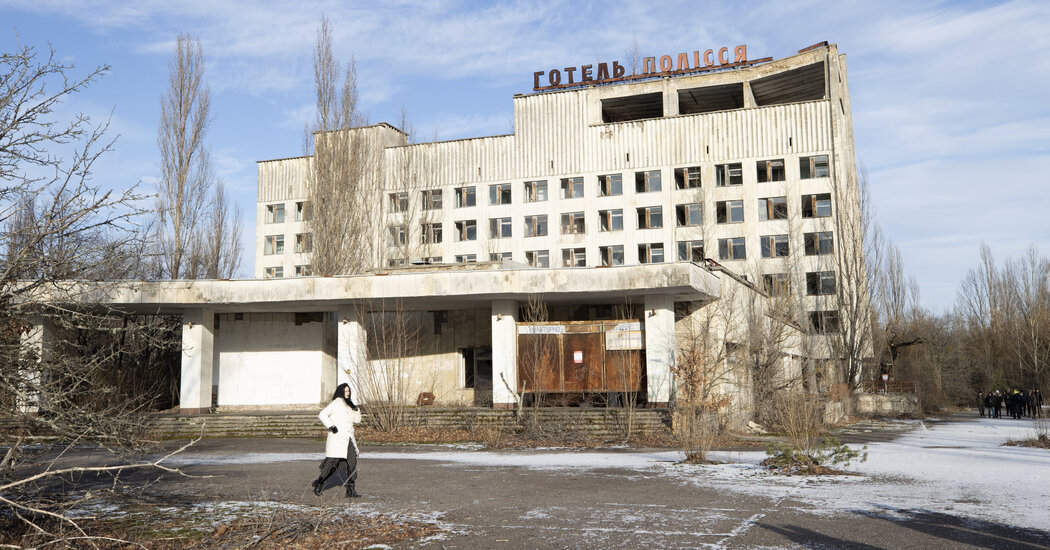
CHERNOBYL, Ukraine — Ukrainian soldiers, Kalashnikov rifles slung over their shoulders, patrolled through a silent, snowy forest, passing homes so long abandoned that vines twirl through the broken windows.
The fields are fallow, the cities deserted and the entire Chernobyl zone in northern Ukraine is still so radioactive it would seem the last place on Earth anybody would want to conquer.
But while most of the attention around a potential invasion by Russia is focused on troop buildups and daily hostilities in the east, the shortest route from Russia to Ukraine’s capital, Kyiv, is from the north. And it passes through the isolated zone around the Chernobyl power plant, where the meltdown of a reactor in 1986 caused the worst nuclear disaster in history.
In one of the incongruities of war, that makes Chernobyl an area that Ukraine thinks it needs to defend, forcing its military to deploy security forces into the eerie and still radioactive forest, where they carry both weapons and equipment to detect radiation exposure.
“It doesn’t matter if it is contaminated or nobody lives here,” said Lt. Col. Yuri Shakhraichuk of the Ukrainian border guard service. “It is our territory, our country, and we must defend it.”
The Ukrainian forces in the area, known as the Chernobyl Exclusion Zone, would not be sufficient to rebuff an invasion, if one came; they are there mostly to detect warning signs. “We collect information about the situation along the border” and convey it to Ukraine’s intelligence agencies, Colonel Shakhraichuk said.
The concept of the Chernobyl Exclusion Zone when Soviet authorities established it three decades ago was to limit, through isolation, the lethality of the accident at the nuclear plant. Radioactive particles left in the soil or trapped under the containment structure of the destroyed reactor while they slowly decay would pose little risk to soldiers, as long as those soldiers did not linger in highly irradiated areas. But the land must be abandoned, in some places for hundreds of years.
Two months ago, the government deployed additional forces into the area, because of increased tensions with Russia and Belarus, a Kremlin ally whose border is five miles from the stricken reactor and where Russia has recently moved troops.
“How can this be?” said Ivan Kovalchuk, a Ukrainian firefighter who helped extinguish the fire at the plant in the first days after the accident, risking his life alongside Russians and people from around the former Soviet Union. He said he was outraged that Russia could potentially menace the zone militarily.
“We liquidated the accident together,” Mr. Kovalchuk said. “For them to do this to us now just makes me feel sorry for people” in Ukraine, he said.
The Chernobyl nuclear power plant’s reactor No. 4 exploded and burned during a test on April 26, 1986, releasing about 400 times more radiation than the bombing at Hiroshima. Thirty people died in the immediate aftermath of the accident, most from radiation exposure; studies of longer-term health effects have been mostly inconclusive but suggest that there could eventually be thousands of deaths from cancer.
While the zone is uninhabitable, it does draw tourists for short visits, generating some income, and is seen in Ukraine as a teachable moment on recent history.
At the time of the accident, Ukraine was a Soviet republic, and initially, the Soviet authorities tried to cover up the disaster. To avoid raising suspicions, they went ahead a few days later with May Day parades in Ukraine, marching schoolchildren through swirling radioactive dust.
This callous attitude helped stir anti-Soviet sentiment throughout Russia, Belarus and Ukraine, the republics most affected, and the accident is now seen as one cause of the collapse of the Soviet Union five years later.
The Chernobyl zone covers about 1,000 square miles straddling the shortest direct route from the Belarusian border to Kyiv. While it is not necessarily the most likely invasion route from the north, because it is swampy and densely forested, Ukraine has not ruled it out.
Before last fall, the 700 miles of border between Ukraine and Belarus were almost unguarded, particularly in the irradiated areas. About 90 miles of the border separates the Ukrainian zone from a similarly isolated and irradiated area in Belarus, called the Polesie State Radioecological Reserve.
That changed in November amid a migrant crisis in Belarus and a troop buildup in Russia.
The two developments were ominous in combination. Moscow began massing troops in a way that suggested plans for an incursion into Ukraine via Belarus. Kyiv also feared that Belarus might create a provocation such as herding migrants toward the Ukrainian border — as Belarus did with Poland — and provide the spark for war.
Ukraine responded by deploying 7,500 additional guards to the Belarusian border. Colonel Shakhraichuk, of the border service, said he could not disclose how many went specifically to Chernobyl. But fears about an incursion from Belarus have only grown this week as Russia directs troops and equipment there ahead of planned joint exercises with Belarus in February.
Only a dozen or so soldiers were visible in the border area on a recent visit, but officials said others were patrolling elsewhere.
The zone is a sorrowful place to work. In the days after the accident, about 91,000 people were evacuated with just hours’ notice.
Forests grew around their former homes. Peering through the windows reveals clothes, shoes, dishes and other remnants of ordinary lives lying about, covered in dust and lichen.
Understand the Escalating Tensions Over Ukraine
In the largest city, Pripyat, now a ghost town, a propaganda sign still extols the virtues of civilian nuclear energy. “Let the atom be a worker not a soldier,” it reads.
The risk of a war further spreading radiation seems minimal. But one object in the zone is particularly vulnerable: a new, $1.7 billion stainless steel arch over the destroyed reactor, paid for mostly by the United States and about 30 other countries. It was completed in 2016 to prevent the spread of highly radioactive dust.
The town of Chernobyl is still partially occupied by workers who live there during rotations. They maintain the containment structure over the damaged reactor, roads and other infrastructure.
“It’s bad, it’s scary,” Elena Bofsunovska, a clerk at a grocery store, said of the possibility of military action near the destroyed reactor.
“We don’t know what will kill us first, the virus, radiation or war,” Oleksei Prishepa, a worker who was standing at the store’s counter, said with a shrug.
Mr. Prishepa said he would prefer that Ukraine set up the defensive lines further south, giving the irradiated zone over to whomever might want it. “It’s a wasteland,” he said. “No crop will ever grow here.”
Before the Russian buildup, the main security concern in Chernobyl was illegal mushroom picking and collection of scrap metal, activities that risk spreading radiation outside the zone. Police also regularly detain thrill seekers entering illegally for sightseeing.
Most of the time, soldiers on patrol face little risk from radiation. But longer-lived particles remain, creating invisible, lethally dangerous hot spots in the forest. Some emit levels of radiation thousands of times higher than normal. The soldiers have marked routes to avoid these places, which were long ago mapped by scientists.
Still, while patrolling in the zone, the soldiers must carry devices on a lanyard around their necks that continuously monitor exposure; under the protocols for patrolling in the zone, if a soldier stumbles into a highly irradiated patch, he is taken off duty to avoid further exposure.
So far, none of the border guards deployed into the zone in November have been exposed to high doses, according to Colonel Shakhraichuk.
“There are very dangerous places to avoid,” said Maj. Aleksei Vegera, who serves with the Chernobyl police force. Members of that force, accustomed to working in the area, accompany border guards on patrols.
“We do try to be careful,” he said. “But, what can I say, I’m used to it.”
Maria Varenikova contributed reporting.







